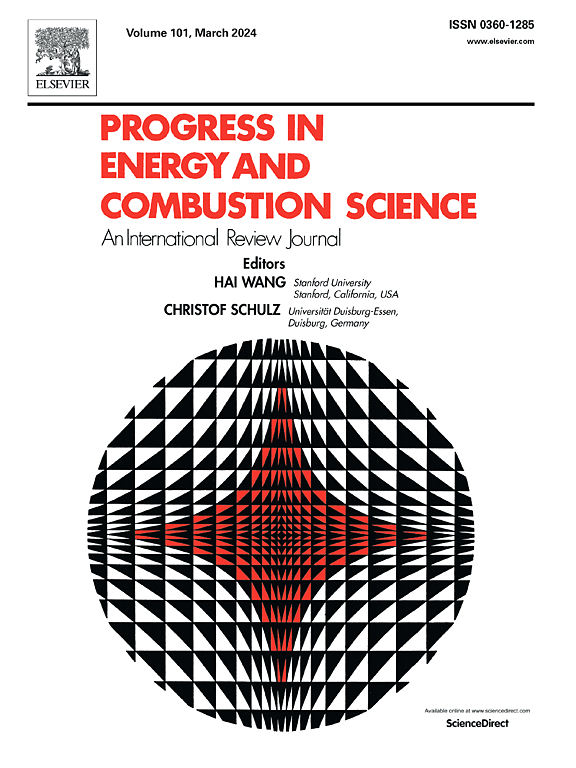Review and assessment of the ammonium perchlorate chemistry in AP/HTPB composite propellant gas-phase chemical kinetics mechanisms
IF 37
1区 工程技术
Q1 ENERGY & FUELS
引用次数: 0
Abstract
Physical and chemical processes of ammonium perchlorate and hydroxyl-terminated polybutadiene (AP/HTPB) composite propellant combustion have been studied for several decades, and more than 50 years of model development can be reported. Computational methods focus on the heterogeneous aspects—the solid-phase and its decomposition—whereas AP self-deflagration and burning characteristics should be seen as a multi-step, physiochemical process. There has been a lack of systematic studies on the gas-phase chemical kinetics mechanisms for AP combustion, with emphasis on the starting gas-phase species NH3 and HClO4. Only three recent detailed gas-phase mechanisms with sufficient detail in terms of the number of chemical reactions and number of species are currently available in the literature prior to 2023, and simulations are carried out within the present review to assess the state of their current performance and to highlight potential knowledge gaps that should be filled. Given the importance and prevalence of AP in modern propellants, it is surprising that the chemical kinetics of AP combustion are very much understudied. The authors highlight the fact that the few existing AP mechanisms have never been fully vetted against an applicable database of experimental results, certainly not in the manner that mechanisms are typically validated within the combustion science community for fuels such as hydrogen and various hydrocarbons. This review does not put forward such a mechanism, but rather 1) brings to light the limitations of current AP kinetics mechanisms in predicting some limited, available kinetics data, and 2) underlines the need for additional, fundamental data that can be used to calibrate an AP kinetics model. A limited gas-phase experimental database was identified from currently available sources for two main compound families: ammonia (NH3) and perchloric acid (HClO4). The decomposition of AP is initiated by NH4ClO4 → NH3 + HClO4 and leads to these two rather complex molecules that differ strongly in their nature and consequently in their reaction schemes for combustion processes. On the one hand, existing measurements of ignition delay times, laminar flame speeds, and speciation were collected for NH3, N2O, and NO2, and on the other hand, a similar albeit much smaller body of experimental results was assembled for HClO4, ClO2, and Cl2. These global kinetics data were used to evaluate modern AP/HTPB propellant models. We observe that there is much room for improvement regarding models' performance. Significant improvements in our ability to model the gas-phase chemical kinetics of AP combustion can be made by taking advantage of recent developments in ammonia oxidation chemistry modeling. However, additional, fundamental data are needed before similar strengthening of the perchlorate-related chemical kinetics as well as for cross-system reactions involving both N- and Cl-based species can be made.
回顾和评估 AP/HTPB 复合推进剂气相化学动力学机制中的高氯酸铵化学性质
对高氯酸铵和羟基封端聚丁二烯(AP/HTPB)复合推进剂燃烧的物理和化学过程的研究已有几十年的历史,可报告的模型开发已有 50 多年的历史。计算方法侧重于异质方面--固相及其分解,而 AP 的自燃和燃烧特性应被视为一个多步骤的物理化学过程。目前还缺乏对 AP 燃烧气相化学动力学机制的系统研究,重点是起始气相物种 NH3 和 HClO4。在 2023 年之前的文献中,目前仅有三篇最新的详细气相机制研究,在化学反应数量和物种数量方面都足够详细,本综述对其进行了模拟,以评估其目前的性能状况,并强调应填补的潜在知识空白。鉴于 AP 在现代推进剂中的重要性和普遍性,令人惊讶的是 AP 燃烧的化学动力学研究却非常不足。作者强调了一个事实,即现有的少数 AP 机制从未根据适用的实验结果数据库进行过全面审查,当然也没有像燃烧科学界通常对氢气和各种碳氢化合物等燃料的机制进行验证的方式。这篇综述并没有提出这样的机制,而是:1)揭示了当前 AP 动力学机制在预测一些有限的、可用的动力学数据方面的局限性;2)强调了需要更多可用于校准 AP 动力学模型的基础数据。从目前可获得的资料中,我们确定了两个主要化合物系列的有限气相实验数据库:氨(NH3)和高氯酸(HClO4)。AP 的分解是由 NH4ClO4 → NH3 + HClO4 开始的,这两种相当复杂的分子在性质上有很大不同,因此在燃烧过程中的反应方案也不同。一方面,我们收集了 NH3、N2O 和 NO2 的点火延迟时间、层流火焰速度和标样的现有测量数据;另一方面,我们还收集了 HClO4、ClO2 和 Cl2 的类似实验结果,尽管数量要少得多。这些总体动力学数据被用来评估现代 AP/HTPB 推进剂模型。我们发现,模型的性能还有很大的改进空间。通过利用氨氧化化学建模的最新进展,我们可以显著提高 AP 燃烧气相化学动力学建模的能力。然而,在对与高氯酸盐有关的化学动力学以及涉及 N 和 Cl 物种的跨系统反应进行类似的强化之前,还需要更多的基础数据。
本文章由计算机程序翻译,如有差异,请以英文原文为准。
求助全文
约1分钟内获得全文
求助全文
来源期刊

Progress in Energy and Combustion Science
工程技术-工程:化工
CiteScore
59.30
自引率
0.70%
发文量
44
审稿时长
3 months
期刊介绍:
Progress in Energy and Combustion Science (PECS) publishes review articles covering all aspects of energy and combustion science. These articles offer a comprehensive, in-depth overview, evaluation, and discussion of specific topics. Given the importance of climate change and energy conservation, efficient combustion of fossil fuels and the development of sustainable energy systems are emphasized. Environmental protection requires limiting pollutants, including greenhouse gases, emitted from combustion and other energy-intensive systems. Additionally, combustion plays a vital role in process technology and materials science.
PECS features articles authored by internationally recognized experts in combustion, flames, fuel science and technology, and sustainable energy solutions. Each volume includes specially commissioned review articles providing orderly and concise surveys and scientific discussions on various aspects of combustion and energy. While not overly lengthy, these articles allow authors to thoroughly and comprehensively explore their subjects. They serve as valuable resources for researchers seeking knowledge beyond their own fields and for students and engineers in government and industrial research seeking comprehensive reviews and practical solutions.
 求助内容:
求助内容: 应助结果提醒方式:
应助结果提醒方式:


